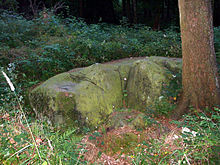Leistrup forest
The Leistrup Forest is part of the Eggegebirge Nature Park and the southern Teutoburg Forest . It is located about 4 km east of the Detmold town center in the Diestelbruch district and has a size of around 3.75 km². The name comes from the neighboring Gut Leistrup , which was first mentioned in 1390.
The subsoil of the Leistrup forest is made up of light-gray sandstone and black-gray clay , which arose in the Triassic around 200 million years ago. The mighty sandbanks are up to 2 m thick, so that reading stones of several square meters can be found. The water-retaining property of the clay layer provides springs, pools and small swamp areas. The Wörbke and Wedasch , both right tributaries of the Werre, arise in the Leistrup forest . The tree population consists mainly of red beech , red alder and sessile oak .
At various points in the Leistrup forest, there are conspicuous, in a row, as well as circular and horseshoe-shaped stone settings , the interpretation and dating of which is scientifically controversial. In addition to cultic interpretations that emerged in the 1920s and 30s, it is also believed that these stone settings were created during the use of the area as a Hudewald in order to protect forest gardens and areas from grazing cattle. It was not until 1850 that the Leistrup forest was closed to herds as a result of the Hude Replacement Act . By removing stones for house building and other purposes, many of the stone rows are already severely disturbed. There are also larger blocks of rock, popularly known as sacrificial stones , at two locations . An interpretation of these sacrificial stones as an old Germanic place of worship is also scientifically controversial.
A cairn grave was examined by the Lippisches Landesmuseum in 1979 on a 2 km long educational forest trail in the western area of the Leistrup forest . The roughly 3,500 year old grave site was badly damaged in the 19th century when stones were removed to build roads. Nevertheless, the grave could be restored. It has a diameter of 8 to 8.5 m and the core mound is covered by a 30 cm thick mantle of light-colored clay. A circular dry stone wall made of sandstones is interrupted at regular intervals by vertically arranged sandstone blocks. A bronze brooch was found in the burial chamber , which made it possible to determine the age of the burial site. More burial sites were found outside the hill. These are 14 narrow, head-high pits that were apparently dug for subsequent burials .
Individual evidence
- ^ Christian Kuhnke: Lippe Lexikon . Detmold 2000, ISBN 3-935454-00-7 .
- ↑ a b c Leistrup forest. (PDF; 5.2 MB) (No longer available online.) Archived from the original on June 2, 2010 ; Retrieved September 1, 2010 . Info: The archive link was inserted automatically and has not yet been checked. Please check the original and archive link according to the instructions and then remove this notice.
literature
- Christian Kuhnke: Lippe Lexicon . Detmold 2000, ISBN 3-935454-00-7 .
- Wilhelm Tiemann: The Leistrup forest as a fuel supplier . In: Heimatland Lippe . Issue 6/1991.
- Helmut Luley: The Leistrup forest in prehistoric times . In: Heimatland Lippe . Issue 6/1991.
- Dieter Berg: Sacrificial stones in the Leistrup forest . In: Heimatland Lippe . Issue 6/1980.
Web links
- Leistrup Forest - Flyer (PDF; 5.2 MB)
Coordinates: 51 ° 55 ′ 28.6 " N , 8 ° 57 ′ 15.4" E



